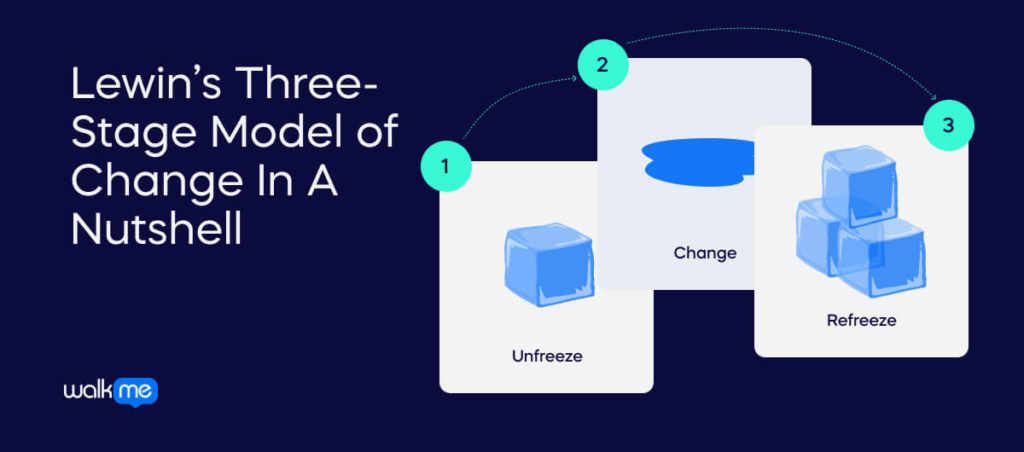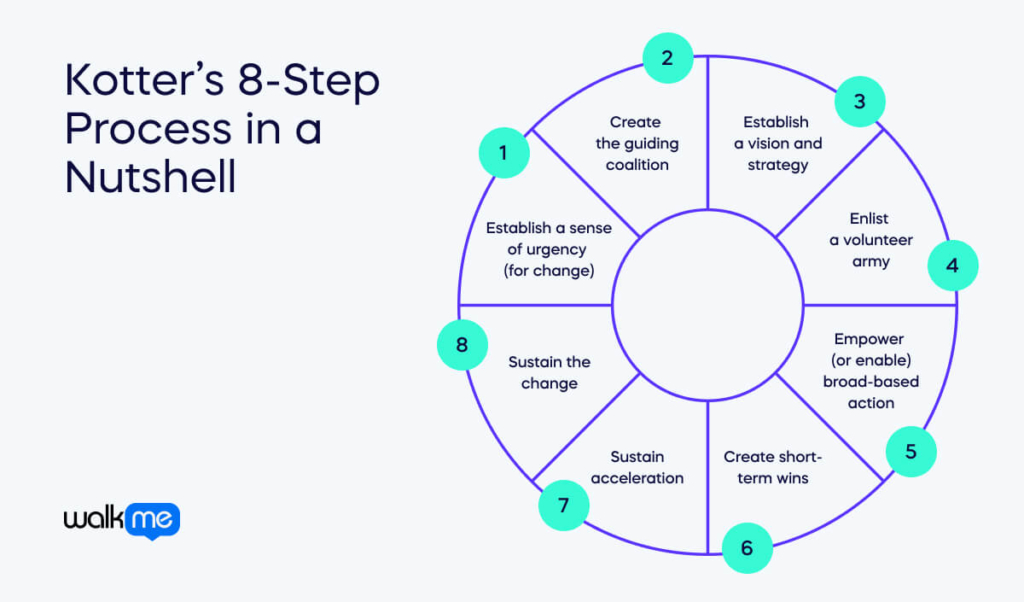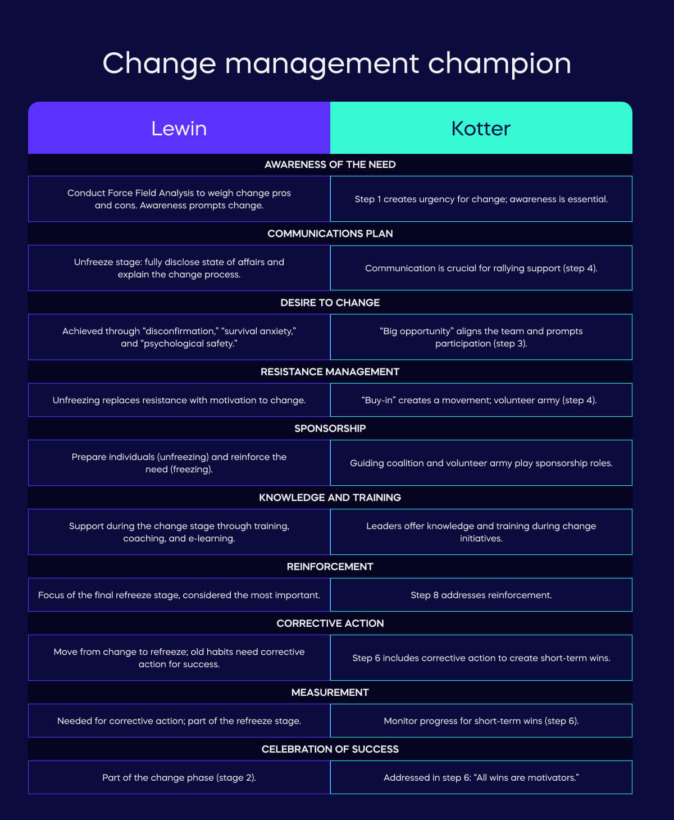If you’re a change management expert, you’ve probably sat and wondered: who would win in a fight if it was Lewin vs Kotter?
Lewin’s Three-Stage Model of Change and Kotter’s 8-Step Model are two of the most well-known and respected theories in change management.
But how do they compare side by side, and which will be best for your needs?
Consider the differences between Kotter and Lewin to help you avoid joining the 70% of enterprises whose digital transformations fail.
To help you understand which is a stronger change management theory when comparing Lewin vs Kotter, we will explore the following topics:
- Lewin’s Three-Stage Model of Change
- Kotter’s 8-Step Change Model
- Battle of the change theories: Lewin and Kotter comparison
How do you approach a change management model comparison?
Change management models are drastically different as their design fits the various needs of differing enterprises.
However, there are questions you can ask to ensure you remain focused on your needs and whether a change management model will deliver when comparing change models.
To assess the suitability of a change management model, consider the following questions through the lenses of processes, technology, change leadership, and organizational culture:
- What are the problems we need to solve?
- What is the scale of the change we want to achieve?
- What will the impact of the change be for the organization?
- Who is most and least likely to embrace the change and why?
- Within what timeframe do we intend to execute this change?
- What amount of resources are required for implementing the change?
- How does the model support our team in adjusting to the changes post-implementation?
Ask yourself these questions and record the answers before comparing change models like Lewin’s Three-Stage Model of Change and Kotter’s Eight-Step Model to ensure you choose the best for your needs.
Lewin’s Three-Stage Model of Change In A Nutshell

Lewin’s Three-Stage Model of Change is a framework for understanding organizational change. It consists of three main stages:
1. Unfreeze
In the first stage, the organization must “unfreeze” to allow the behavior, systems, and process changes to happen.
During the unfreezing phase, the motivations for the change need to be understood, and leaders must explain them to the entire organization.
The key to leadership during this phase is to develop a compelling message. It must explain why sustaining the previous status quo is impossible and provide a vision for the future.
Communication is, therefore, especially important during the unfreezing stage.
2. Change
The second stage is “change”.
During this stage, the organization accepts the change plan and is transitioning to a new way of doing things.
It’s especially important at this stage that employees and the role of supervisor become pivotal in the changes.
3. Refreeze
The final stage is “refreeze”.
At this stage of Lewin’s model, consistency is vital so that the staff internalizes the changes, and leaders monitor them for reinforcement and adjust if needed.
According to Stichler: “If the change is to be sustained or ‘stick’ over time, the leader must play a pivotal role…by reinforcing the new behaviors with positive feedback, encouragement, recognition, and rewards…”
The model’s main benefit is its simplicity—it provides an easy-to-understand framework for managing the change process.
Kotter’s 8-Step Process in a Nutshell

Unlike Lewin’s change management model, Kotter’s model has eight steps. That’s five more stages than Lewin’s, so what has he added?
The eight steps are:
- Establish a sense of urgency (for change): Uncover threats to the business, articulate the consequences of neglecting them, and highlight the potential benefits change can bring.
- Create the guiding coalition: Recognize advocates for change across all organizational levels and equip them with the information to steer those within their sphere of influence forward.
- Establish a vision and strategy: Begin with the ultimate goal in mind. Define what you aim to accomplish and envision success. Within your strategic vision, outline the steps for the change initiative’s progression.
- Enlist a volunteer army: Communication must be transparent, sincere, compelling, and frequent. People are more likely to support what they comprehend when it impacts them.
- Empower (or enable) broad-based action: Provide individuals with the knowledge, skills, and tools to implement change. Identify and swiftly eliminate barriers to success. Acknowledge and reward positive behaviors.
- Create short-term wins: Incorporate incremental, rapid wins into the change management strategy and celebrate them enthusiastically. Success fosters further success.
- Sustain acceleration: Throughout the initiative, identify effective strategies and promptly apply them to ongoing challenges.
- Sustain the change: Continuously communicate the vision. Share success stories regularly, ensure leaders exemplify the right behaviors and offer ongoing training and support to all affected parties.
Kotter’s 8-step process aims to focus on driving organizational change. Lewin’s model, by contrast, was created concerning change more generally.
So it’s true that these two theories have their differences as they are change models, not both organizational change management models, and differ in their ways of implementing change. But are there similarities between them?
Battle of the change theories: Lewin vs Kotter comparison table

Below is a comparison table of the two most popular change management tools.
Reviewing the Lewin change management model alongside Kotter’s 8-step process, we can now see which theory covers what principle. We can also see how each concept is referenced and incorporated into both change theories.
Search:
Tool / Concept / Challenge
Lewin Kotter
Awareness of the need
Lewin advised conducting Force Field Analysis (driving and restraining forces) to weigh the pros and cons of the change. Regarding Lewin’s model, Edgar Schein asserts that “diagnostic” activities, such as interviews and questionnaires, are already powerful interventions. In essence, awareness of the need to change can prompt change itself.
Step 1 is all about creating “urgency” for change. There can be no urgency without awareness of the change process’s significance.
Communications plan
Regarding Lewin’s unfreeze stage, Tools Hero writes: “It is essential for a business to disclose the state of affairs fully and to explain why a change process will come into force.
As a result of clear communication, employees are more willing to accept the new change of direction, and they can let go of old customs.”
Kotter mentions communication as one of the coalition’s guiding responsibilities. Large-scale change can only occur when many people rally around a common opportunity (step 4), and this step cannot take place without a communications plan.
Desire to change
Edgar Schein states that this comes about through the right balance of “disconfirmation,” “survival anxiety,” and “psychological safety” during Lewin’s unfreeze stage.
Kotter refers to “the big opportunity.” It’s not just a vision (step 3). It’s also a “compelling, aspirational catalyst. It aligns your team around who they want to become together and prompts others to raise their hands to help make it happen.”
Resistance management
The unfreezing stage addresses resistance to change and replaces it with motivation to change.
Kotter flips resistance on its head and talks about “buy-in.” Instead of presenting an idea, you have to create a movement. This step is where the volunteer army (step 4) comes in.
Sponsorship
Lewin emphasized the importance of preparing individuals for change (unfreezing) and reinforcing the need for change (freezing). Sponsorship would play a part in this.
The guiding coalition and volunteer army are essential steps in Kotter’s process. They both play crucial sponsorship roles.
Knowledge and training
Support is a crucial part of the change stage. It is usually in training exercises, coaching, and e-learning tools.
Kotter assumes leaders offer knowledge and training as part of change initiatives.
Reinforcement
This step is the main focus of the final refreeze stage, which he labeled the most important.
Step 8 addresses this action.
Corrective action
This part of the process moves from change to refreeze. Old habits can return without corrective action, and the final stage will be unsuccessful.
Corrective action will occur if necessary to create short-term wins (step 6).
Measurement To take any corrective action, measurement is needed. This action is part of the refreeze stage.
Monitor progress to create short-term wins (step 6).
Celebration of success
This action would be part of stage 2, the change phase.
This is specifically addressed in step 6: “Some wins are big, some are small—all wins are motivators.”
Lewin and Kotter hold similar value for change management
A fight between Kotter and Lewin would be a pretty close one. Rather than being at odds with one another, they align incredibly well as they’re evenly matched.
Scholars have criticized Lewin for over-simplifying the change process, yet others defend this criticism and disagree, citing its effectiveness in the field.
However, Kotter’s 8-step process fits within Lewin’s foundational model for change.
To give your change initiatives the best chance at success, use the best parts of each change process model for your digital transformation.


